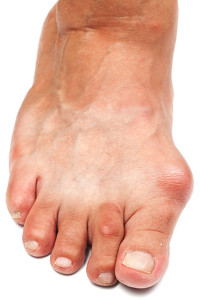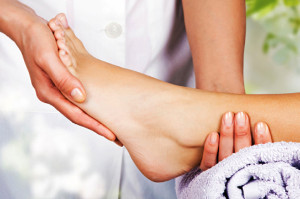Lansing (517) 321-1199

 Patients who experience ingrown toenails are often familiar with the pain and discomfort they cause. They occur as a result of toenails that grow into the surrounding skin, and this may cause an infection. Some of the symptoms that are associated with this condition can include extreme tenderness around the affected area, and a discharge that may ooze from the nail. This ailment is caused by trimming the toenails improperly, and wearing shoes and socks that are too tight. There are effective treatment methods that can be implemented which include removing a portion of the nail, and draining any infection that is present. It is possible to avoid getting ingrown toenails by wearing shoes that fit properly, and trimming the toenails straight across the toe. If you have developed this condition, please consult with a podiatrist who can offer proper treatment advice.
Patients who experience ingrown toenails are often familiar with the pain and discomfort they cause. They occur as a result of toenails that grow into the surrounding skin, and this may cause an infection. Some of the symptoms that are associated with this condition can include extreme tenderness around the affected area, and a discharge that may ooze from the nail. This ailment is caused by trimming the toenails improperly, and wearing shoes and socks that are too tight. There are effective treatment methods that can be implemented which include removing a portion of the nail, and draining any infection that is present. It is possible to avoid getting ingrown toenails by wearing shoes that fit properly, and trimming the toenails straight across the toe. If you have developed this condition, please consult with a podiatrist who can offer proper treatment advice.
Ingrown toenails can become painful if they are not treated properly. For more information about ingrown toenails, contact Dr. Harold Sterling of Michigan. Our doctor can provide the care you need to keep you pain-free and on your feet.
Ingrown Toenails
Ingrown toenails occur when a toenail grows sideways into the bed of the nail, causing pain, swelling, and possibly infection.
Causes
Prevention
Because ingrown toenails are not something found outside of shoe-wearing cultures, going barefoot as often as possible will decrease the likeliness of developing ingrown toenails. Wearing proper fitting shoes and using proper cutting techniques will also help decrease your risk of developing ingrown toenails.
Treatment
Ingrown toenails are a very treatable foot condition. In minor cases, soaking the affected area in salt or antibacterial soaps will not only help with the ingrown nail itself, but also help prevent any infections from occurring. In more severe cases, surgery is an option. In either case, speaking to your podiatrist about this condition will help you get a better understanding of specific treatment options that are right for you.
If you have any questions please feel free to contact our office located in Lansing, MI. We offer the newest diagnostic and treatment technologies for all your foot and ankle needs.
Read more about Ingrown Toenails The purpose of the Achilles tendon is to connect the heel to the calf muscles. It aids in cushioning the feet after landing on the ground while participating in running activities. This tendon often strains significantly while running uphill, and this may cause an Achilles tendon pull. It is beneficial to treat this condition immediately, which consists of performing proper stretching techniques. There are patients who choose to ignore the pain that is often accompanied by this type of injury, which can cause additional damage to the tendon. It is important to learn how to run efficiently which is helpful in preventing Achilles tendon injuries. If you have torn your Achilles tendon, it is advised to consult with a podiatrist who can properly treat this condition.
The purpose of the Achilles tendon is to connect the heel to the calf muscles. It aids in cushioning the feet after landing on the ground while participating in running activities. This tendon often strains significantly while running uphill, and this may cause an Achilles tendon pull. It is beneficial to treat this condition immediately, which consists of performing proper stretching techniques. There are patients who choose to ignore the pain that is often accompanied by this type of injury, which can cause additional damage to the tendon. It is important to learn how to run efficiently which is helpful in preventing Achilles tendon injuries. If you have torn your Achilles tendon, it is advised to consult with a podiatrist who can properly treat this condition.
Achilles tendon injuries need immediate attention to avoid future complications. If you have any concerns, contact Dr. Harold Sterling of Michigan. Our doctor can provide the care you need to keep you pain-free and on your feet.
What Is the Achilles Tendon?
The Achilles tendon is a tendon that connects the lower leg muscles and calf to the heel of the foot. It is the strongest tendon in the human body and is essential for making movement possible. Because this tendon is such an integral part of the body, any injuries to it can create immense difficulties and should immediately be presented to a doctor.
What Are the Symptoms of an Achilles Tendon Injury?
There are various types of injuries that can affect the Achilles tendon. The two most common injuries are Achilles tendinitis and ruptures of the tendon.
Achilles Tendinitis Symptoms
Rupture Symptoms
Treatment and Prevention
Achilles tendon injuries are diagnosed by a thorough physical evaluation, which can include an MRI. Treatment involves rest, physical therapy, and in some cases, surgery. However, various preventative measures can be taken to avoid these injuries, such as:
If you have any questions please feel free to contact our office located in Lansing, MI. We offer the newest diagnostic tools and technology to treat your foot and ankle needs.
Read more about Achilles Tendon Injuries A bunion is considered to be a deformity of the bone. It appears as a protrusion on the side of the big toe, and is often swollen and painful. It is possible for the foot to change shape, and the style of the shoes may have to be altered. The reasons bunions develop can include genetic factors, wearing shoes that fit incorrectly, or medical conditions such as gout or rheumatoid arthritis. This condition can be treated by using bunion pads or wearing custom made orthotics. These may be helpful in alleviating pressure on the foot that comes from the bunion. If this ailment is causing severe pain and daily activities are difficult to complete, surgery may be a consideration for permanent removal of the bunion. Please consult with a podiatrist if you are afflicted with a bunion, and would like additional treatment options.
A bunion is considered to be a deformity of the bone. It appears as a protrusion on the side of the big toe, and is often swollen and painful. It is possible for the foot to change shape, and the style of the shoes may have to be altered. The reasons bunions develop can include genetic factors, wearing shoes that fit incorrectly, or medical conditions such as gout or rheumatoid arthritis. This condition can be treated by using bunion pads or wearing custom made orthotics. These may be helpful in alleviating pressure on the foot that comes from the bunion. If this ailment is causing severe pain and daily activities are difficult to complete, surgery may be a consideration for permanent removal of the bunion. Please consult with a podiatrist if you are afflicted with a bunion, and would like additional treatment options.
If you are suffering from bunion pain, contact Dr. Harold Sterling of Michigan. Our doctor can provide the care you need to keep you pain-free and on your feet.
What Is a Bunion?
Bunions are painful bony bumps that usually develop on the inside of the foot at the joint of the big toe. As the deformity increases over time, it may become painful to walk and wear shoes. Women are more likely to exacerbate existing bunions since they often wear tight, narrow shoes that shift their toes together. Bunion pain can be relieved by wearing wider shoes with enough room for the toes.
Causes
Symptoms
In order to diagnose your bunion, your podiatrist may ask about your medical history, symptoms, and general health. Your doctor might also order an x-ray to take a closer look at your feet. Nonsurgical treatment options include orthotics, padding, icing, changes in footwear, and medication. If nonsurgical treatments don’t alleviate your bunion pain, surgery may be necessary.
If you have any questions, please feel free to contact our office located in Lansing, MI. We offer the newest diagnostic and treatment technologies for all your foot care needs.
Read more about Bunions Patients who have foot pain can benefit from different types of foot therapy. When the feet are soaked in warm water, mild relief may be found. This is helpful in relaxing sore foot muscles. Additionally, having foot massages performed can aid in reducing tension in the body, improving circulation, and may ease any pain that is present. When the toes are spread apart, the muscles that lie underneath are stretched, and this may help to strengthen the entire foot. There are some patients who find it beneficial to use topical treatments which include eucalyptus oil.This provides a different sensation, and may help in relieving existing foot pain. If you would like to learn of additional types of foot therapy, it is advised to schedule a consultation with a podiatrist who can properly guide you.
Patients who have foot pain can benefit from different types of foot therapy. When the feet are soaked in warm water, mild relief may be found. This is helpful in relaxing sore foot muscles. Additionally, having foot massages performed can aid in reducing tension in the body, improving circulation, and may ease any pain that is present. When the toes are spread apart, the muscles that lie underneath are stretched, and this may help to strengthen the entire foot. There are some patients who find it beneficial to use topical treatments which include eucalyptus oil.This provides a different sensation, and may help in relieving existing foot pain. If you would like to learn of additional types of foot therapy, it is advised to schedule a consultation with a podiatrist who can properly guide you.
Foot therapy is often necessary for those recovering from either foot deformities or foot injuries. If you have concerns regarding therapy, Dr. Harold Sterling of Michigan. Our doctor can provide the care you need to keep you pain-free and on your feet.
Most Common Injuries
People who are active or athletes are prone to a variety of injuries. Therefore, it is often important to take part in physical therapy in order to quickly get back on the right track.
What to Do When Injured
Physical Therapy – This specialized treatment will focus on the affected area, speeding up recovery and the overall healing process. It is a proven method that has helped millions of people return from any injury.
During physical therapy you will undergo regimented training to get back into full form. Training is often very difficult, especially at first when the foot feels weak. Physical therapy often involves:
Basic stretching and twisting exercises – getting the feet’s mobility and flexibility up.
Massaging – the therapist will massage the injured area in order to activate the muscles and relax them.
Strengthening Exercises – this allows the muscles in the affected area to regain their full strength, a vital step towards full recovery.
If you have any questions please feel free to contact our office located in Lansing, MI. We offer the newest diagnostic tools and technology to treat your foot and ankle needs.
Read more about Foot Therapy for Sports Injuries